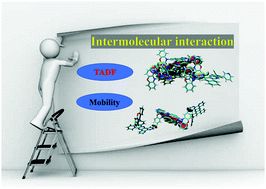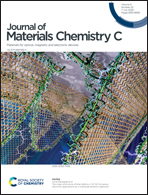The role of intermolecular interactions in regulating the thermally activated delayed fluorescence and charge transfer properties: a theoretical perspective†
Abstract
Thermally activated delayed fluorescence (TADF) materials show promising applications in organic light-emitting diodes (OLEDs). However, molecular packing modes and intermolecular interactions play a significant role in defining the nature of the excited states and their energies and dynamics, further influencing the performance of TADF-OLEDs. A theoretical perspective to study the photophysical and charge transfer properties with explicit consideration of intermolecular interactions in the solid phase is highly desired. Herein, the excited state dynamics of two novel TADF molecules, namely, BPPZ-PXZ and mDPBPZ-PXZ in toluene and solid phase are studied by the polarizable continuum model (PCM) and the combined quantum mechanics and molecular mechanics (QM/MM) method, respectively. The intermolecular interactions are visually evaluated by the independent gradient model (IGM) method and quantitatively calculated by the molecular force field energy decomposition method. Based on the thermal vibration correlation function (TVCF) method, the intersystem crossing (ISC) and reverse intersystem crossing (RISC) processes are studied. Moreover, the charge carrier mobilities of the two compounds are investigated by the Marcus equation and Monte Carlo simulations. The results indicate that the different packing modes and intermolecular interactions have remarkable influence on the S1–T1 gap, spin orbital coupling effect and transition properties. The stronger intermolecular interaction in the mDPBPZ-PXZ crystals results in promoted RISC processes and superior TADF features than that of BPPZ-PXZ. Furthermore, the balanced and bipolar charge transfer features are verified for the studied compounds, and a rational molecular design strategy with modifications in the BPPZ and mDPBPZ units is proposed to regulate the photophysical and charge transfer properties. Through this work, we would like to shed light on the relationship among molecular structures, intermolecular interactions and TADF as well as charge transfer properties, which may help take advantage of the unique molecular design to develop high-performance emitting molecules.



 Please wait while we load your content...
Please wait while we load your content...